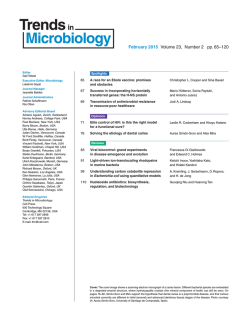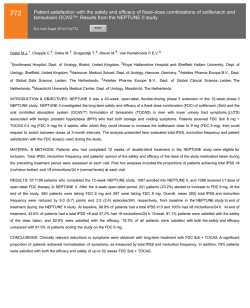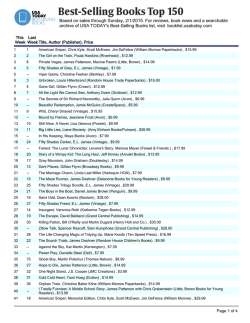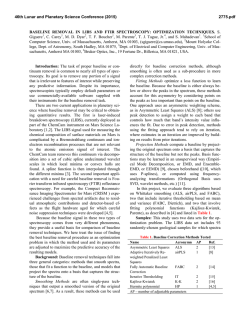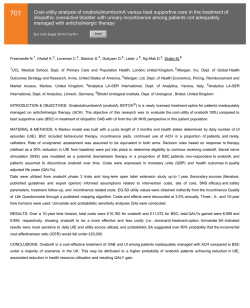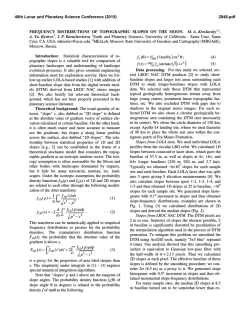
574 Cardiovascular safety of combination treatment with mirabegron
574 Cardiovascular safety of combination treatment with mirabegron and solifenacin in patients with overactive bladder in a randomised, double-blind, dose-ranging, Phase II study (Symphony) Eur Urol Suppl 2014;13;e574 Print! Print! Abrams P. 1 , Kelleher C.2 , Staskin D.3 , Kay R.4 , Martina R.5 , Newgreen D.5 , Paireddy A. 5 , Van Maanen R.5 , Ridder A. 5 1 Southmead Hospital, Bristol Urological Institute, Bristol, United Kingdom, 2 Guy's and St Thomas' NHS Foundation Trust, Dept. of Urology, London, United Kingdom, 3 Tufts University School of Medicine, Dept. of Urology, Boston, United States of America, 4 RK Statistics Ltd, RK Statistics Ltd, Bakewell, United Kingdom, 5 Astellas Pharma BV, Leiden, The Netherlands INTRODUCTION & OBJECTIVES: The combination of the β3 -adrenoceptor agonist, mirabegron (MIRA), and the antimuscarinic agent, solifenacin (SOLI), have been shown to improve efficacy in the treatment of OAB. An objective of this study was to compare safety and tolerability of mirabegron and solifenacin combination therapy vs monotherapy and placebo in overactive bladder (OAB) patients. Here we report on cardiovascular (CV) safety parameters. MATERIAL & METHODS: This Phase II, factorial design, multicentre, randomised, double-blind, parallel-group, placebo- and monotherapycontrolled trial, enrolled male and female patients aged ≥18 years with symptoms of OAB for ≥3 months. At baseline, patients were randomised to one of 12 treatment groups for 12 weeks in a 2:1 ratio for primary (SOLI 5 mg; SOLI 2.5 + MIRA 25 mg; SOLI 2.5 mg + MIRA 50 mg; SOLI 5 mg + MIRA 25 mg; SOLI 5 mg + MIRA 50 mg) vs secondary (placebo; SOLI 2.5 mg; SOLI 10 mg; MIRA 25 mg; MIRA 50 mg; SOLI 10 mg + MIRA 25 mg; SOLI 10 mg + MIRA 50 mg) groups of interest. Vital signs (blood pressure [BP] and pulse rate) and ECG parameters were assessed at baseline, and at each study visit; vital signs were assessed by investigator (office based device) and patient at home (AM and PM diary recordings over 5 consecutive days [data not shown]). The mean change from baseline for each variable at end of treatment (EoT) was analysed using an analysis of covariance (ANCOVA) model with mirabegron and solifenacin dose as the main factors; their interaction, sex, age group, and geographic region as fixed factors, and baseline value as a covariate. Least Squares Means and 95% confidence intervals were presented for parameters of interest. RESULTS: In total, 1306 patients received ≥1 dose of study drug (Safety Analysis Set). No clear or dose-related differences were observed between combination and solifenacin and/or mirabegron monotherapy for the mean change from baseline to EoT in BP, pulse rate, or QTcF interval (Table). The effect of mirabegron on vital signs, and the small prolongation in QTcF with solifenacin, were observed in apparently unaltered magnitude in the combination groups. CONCLUSIONS: The combination of mirabegron and solifenacin may provide an attractive therapeutic approach to maximize efficacy without CV safety concerns.
© Copyright 2025
